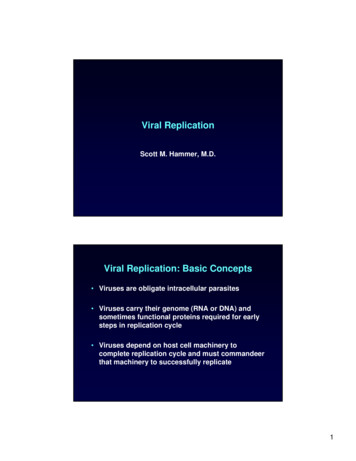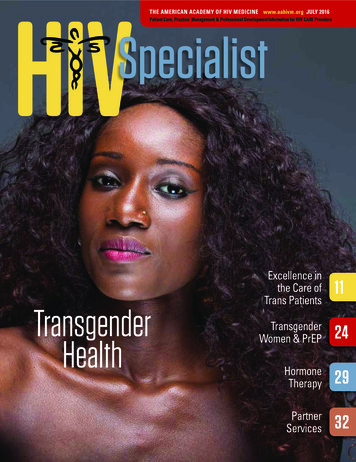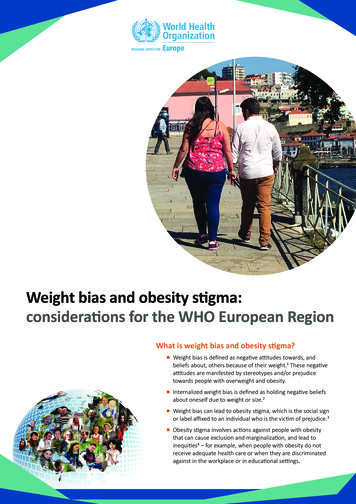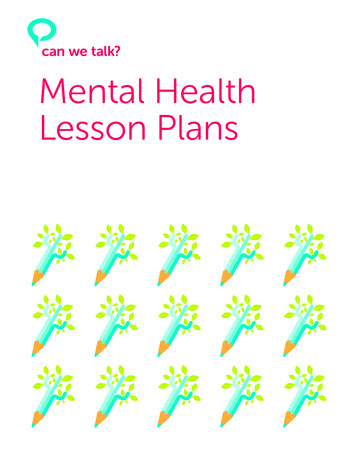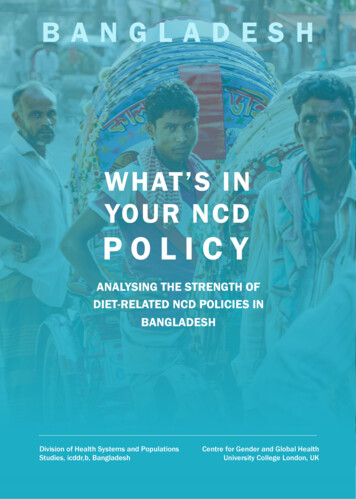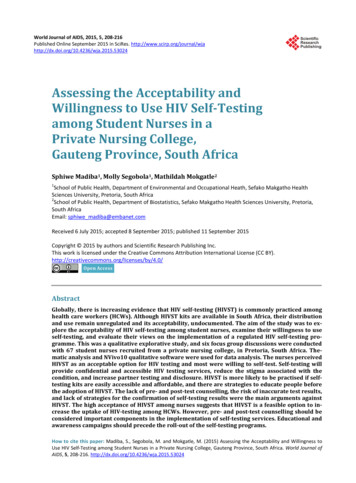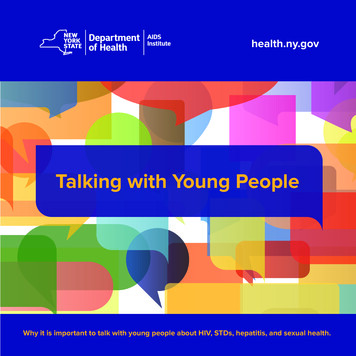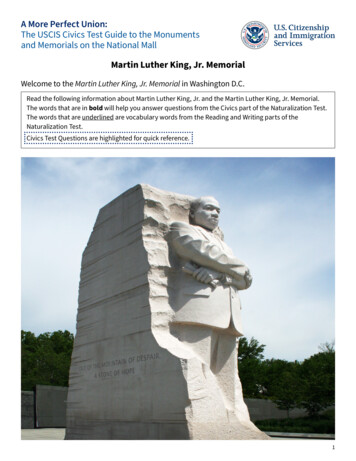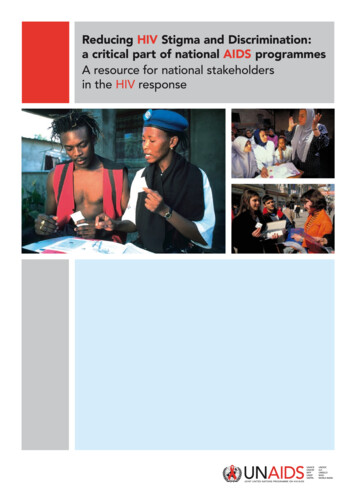
Transcription
Reducing HIV Stigma and Discrimination:a critical part of national AIDS programmesA resource for national stakeholdersin the HIV response
Cover photos by G. Pirozzi, L. Taylor and S. NooraniUNAIDS/07.32E / JC1420E (English original, December 2007) Joint United Nations Programme on HIV/AIDS (UNAIDS) 2007. All rights reserved.The designations employed and the presentation of the material in this publication donot imply the expression of any opinion whatsoever on the part of UNAIDS concerningthe legal status of any country, territory, city or area or of its authorities, or concerningthe delimitation of its frontiers or boundaries.UNAIDS does not warrant that the information contained in this publication is completeand correct and shall not be liable for any damages incurred as a result of its use.Acknowledgements: On behalf of UNAIDS, this document was researched and writtenby Anne Stangl and Laura Nyblade of the International Center for Research on Women,with assistance from Dara Carr (Independent Consultant), ongoing research supportfrom Traci Eckhaus, and editorial assistance from Margo Young.Suggested citation: UNAIDS (2007), Reducing HIV Stigma and Discrimination:a critical part of national AIDS programmes. Geneva: Joint United Nations Programmeon HIV/AIDS.WHO Library Cataloguing-in-Publication DataReducing HIV stigma and discrimination: a critical part of national AIDSprogrammes: a resource for national stakeholders in the HIV response.“UNAIDS / 07.32E”.1.HIV infections - psychology. 2. Acquired immunodeficiency syndrome psychology. 3.Prejudice. 4.Social alienation. 5.National health programs.I.UNAIDS.ISBN 978 92 9 173636 2(NLM classification: WC 503.6)UNAIDS – 20 avenue Appia – 1211 Geneva 27 – SwitzerlandTelephone: ( 41) 22 791 36 66 – Fax: ( 41) 22 791 48 35E-mail: distribution@unaids.org – Internet: http://www.unaids.org
Reducing HIV Stigma andDiscrimination: a critical partof national AIDS programmesA resource for national stakeholdersin the HIV response
Reducing HIV Stigma and Discrimination: a critical part of national AIDS programmesA resource for national stakeholders in the HIV responseTABLE OF CONTENTSEXECUTIVE SUMMARY5INTRODUCTION7SECTION 1Why stigma and discrimination are major “road blocks”to universal access to HIV prevention, treatment, care and supportBox 1: Defining HIV and AIDS-related stigma and discrimination (p.9)Box 2: Stigma and HIV services: selected statistics (p.9)9SECTION 2How national AIDS programmes can reduce stigma and discriminationTable 1: Addressing the causes of stigma and discrimination (p.11)Table 2: An effective national response to reduce stigma and discrimination. (p.13)Box 3: People Living with HIV Stigma Index (p.13)11SECTION 3Steps toward effective responses to HIV stigma and discriminationTable 3: A Strategy for Programmatic Action to Reduce Stigma & Discrimination (p.18)17CONCLUSION21REFERENCES22ANNEX AReducing HIV stigma and discrimination: successful programmes Belarus India Thailand Brazil Namibia Uganda Caribbean South Africa Venezuela China Sub-Saharan Africa Viet Nam Haiti Tanzania Zambia25ANNEX BMeasuring stigma and discrimination43ANNEX CResources for conducting stigma and discrimination-reduction activities47ANNEX DKey points for advocacy on HIV stigma and discrimination513
UNAIDS4
Reducing HIV Stigma and Discrimination: a critical part of national AIDS programmesA resource for national stakeholders in the HIV responseEXECUTIVE SUMMARYDespite the pervasiveness of HIV-related stigma and discrimination in national HIV epidemics andtheir harmful impact in terms of public health and human rights, they remain seriously neglected issuesin most national responses to HIV.“Since the beginning of the epidemic, stigma, discrimination, and gender inequality have been identified as major obstacles to effective responses to HIV. Yet there has never been serious politicaland programmatic commitment to doing anything about them.”– Peter Piot, Executive Director, Joint United Nations Programme on HIV/AIDS [2]National AIDS programmes – together with key partners – can take concrete steps to address thesecritical obstacles and help pave the way towards universal access to prevention, treatment, care andsupport. The UN system, funding mechanisms and bilateral partners can support countries – throughadvocacy, strategic planning, technical assistance, resource mobilisation and other means – to reducestigma and discrimination related to HIV. These efforts will not only help countries reach key targetsfor universal access and Millennium Development Goal 6, they will also protect and promote humanrights, foster respect for people living with HIV and other affected groups, and reduce the transmission of HIV.How can national AIDS authorities, UNAIDS, UN Joint Teams on AIDS and otherpartners help reduce stigma and discrimination? Build an understanding of and commitment to stigma and discriminationreduction by using existing tools for measuring stigma and discrimination to “know yourepidemic” in terms of the prevalence of stigma and discrimination and their impact on theresponse to HIV. Provide leadership on the necessity of reducing stigma and discrimination innational AIDS responses. Inspire leadership, understanding, and high-level commitmentregarding the need to seriously expand efforts to address stigma and discrimination in nationalAIDS programmes. Facilitate the inclusion of stigma/discrimination reduction in national HIVstrategic planning, funding and programming activities. Ensure that planning, fundingand programming efforts include attention to stigma and discrimination and support theimplementation of promising programmes to address stigma and discrimination. Use or promote approaches that address the root causes of stigma anddiscrimination. Implement programmes that tackle the actionable causes of stigmsa, i.e. lackof awareness of stigma and discrimination and their negative consequences; fear of acquiringHIV through casual contact; and linking HIV with behaviour that is considered immoral orimproper.5
UNAIDS Advocate for a multifaceted national approach to stigma and discrimination.A national response which employs a range of approaches will have the greatest impact,e.g. “know your rights” campaigns; social change communication; social mobilization;participatory education; interaction between people living with HIV and key audiences;celebrity champions and media campaigns; legal support to those affected by stigma anddiscrimination. Facilitate the scale-up of effective programmes. National AIDS programmes – workingwith partners – can identify promising approaches to stigma and discrimination that can betaken to scale to achieve sufficient impact across the country. Promote and facilitate programme evaluation and operational research. Measurementhelps evaluate effectiveness and the identification of programmes to scale up and can be built intoprogrammes during design and implementation.6
Reducing HIV Stigma and Discrimination: a critical part of national AIDS programmesA resource for national stakeholders in the HIV responseINTRODUCTION“ If we do not appreciate the nature and impact of stigma, none of our interventions can begin tobe successful. AIDS is probably the most stigmatised disease in history.”– Edwin Cameron [7]National AIDS programmes and the international community have embraced the goal of universalaccess to HIV prevention, treatment, care and support by 2010 [9]. To achieve this goal, countrieswill need to address the obstacles blocking provision and uptake of prevention, treatment, care andsupport. From the late 1980s to the commitment to universal access (2005-2006), experts and communities have consistently identified HIV-related stigma and discrimination as critical barriers toeffectively addressing HIV [11]. In addition to being globally pervasive, stigma and discriminationoperate at multiple levels throughout society: within individuals, families, communities, institutionsand media, and in government policies and practices [12, 13]. Yet despite the recognition of the significance and prevalence of stigma and discrimination, almost no country has prioritized activities toreduce or eliminate them in their national AIDS plans or programmes. Unless this changes, universalaccess will not be achieved.UNAIDS/G. PirozziUNAIDS/L. TaylorUNAIDS/G. PirozziThis document presents strategies, programme examples and research findings concerning how governments, the UN system, donors and civil society can make the reduction of HIV-related stigmaand discrimination central in the national response to AIDS. Development partners – as they support national authorities and civil society partners in scaling up toward universal access – can inspiregreater political, financial and programmatic commitment to address stigma and discrimination innational AIDS responses. UNAIDS and United Nations Joint Teams on AIDS can work with nationalauthorities to ensure that national strategic plans for achieving universal access address the multipleways that stigma and discrimination hinder HIV prevention, testing and counselling, care, supportand treatment. Most importantly, Government leaders and national AIDS authorities can make thereduction of stigma and discrimination a key pillar of national AIDS strategies and programmes bothto protect those affected and to reduce the transmission and impact of HIV.7
UNAIDS8
Reducing HIV Stigma and Discrimination: a critical part of national AIDS programmesA resource for national stakeholders in the HIV responseUNAIDS/G. PirozziSECTION 1Why stigma and discrimination are major “road blocks” to universalaccess to HIV prevention, treatment, care and supportIn many countriesand communities, thestigma associated withHIV and the resultingdiscrimination can beas devastating as theillness itself: abandonment by spouse and/or family, social ostracism, job and property loss, schoolexpulsion, denial of medical services, lack of care and support, and violence. These consequences, or fear of them,mean that people are less likely to come in for HIV testing, disclose their HIV status to others, adopt HIV preventive behaviour, or access treatment, care and support.If they do, they could lose everything.UNAIDS/B. NeelemanLower Uptake of HIV Preventive Services and Testing andCounsellingGlobally, stigma anddiscriminationareassociated with loweruptake of HIV preventive services, includingunder- or non-participation in HIV information meetings andcounselling [14] and reduced participation in programmes toprevent mother-to-child transmission [15, 16]. Stigmatisingattitudes are associated with denial of risk and a lower likelihood of adopting preventive behaviours [17, 18]. Both thefear of stigma [15, 19] and stigmatising beliefs – which perpetuate the notion that HIV only happens to others – keeppeople from HIV testing [19] in numerous contexts.Reduced and Delayed DisclosureDisclosure of HIV serostatus is key for outcomes ranging fromcondom use to care-seeking. Numerous studies have foundstigma and discrimination adversely affect disclosure to partners, health care providers and family members [3, 10, 20].Postponement or Rejection of Treatment, Care and SupportResearchers have connected stigma and discriminationwith postponing or rejecting care, travelling outside localcommunities for care because of fear of breaches of confi-Box 1 – Defining HIV-related stigmaand discriminationUNAIDS defines HIV-related stigma and discrimination as: “ a ‘process of devaluation’ ofpeople either living with or associated with HIVand AIDS Discrimination follows stigma and isthe unfair and unjust treatment of an individualbased on his or her real or perceived HIV status.” [1] It is important to note that even if aperson feels stigma towards another, s/he candecide to not act in a way that is unfair or discriminatory.Box 2 – Stigma and HIV services:selected statisticsPrevention and testing In Botswana, a survey of patients receivingantiretroviral therapy found 40 per cent delayed getting tested for HIV, mostly due tostigma [3]. In a survey of injecting drug users inIndonesia, 40 per cent said stigmatisationwas why drug users avoided HIV testing [4].Disclosure A study among Tanzanian persons livingwith HIV found only half of respondents haddisclosed their status to intimate partners.Among those who disclosed, the averagetime from knowing to disclosure was 2.5years for men and 4 years for women [6].Stigma contributed to delayed disclosure.Care and Treatment In a survey of more than 1,000 healthcareprofessionals working directly with HIV patients in four Nigerian states, 43 per centobserved others refusing a patient with HIVhospital admission [8]. In Jamaica, researchers found that morethan two-thirds of newly diagnosed AIDScases in 2002 tested late in the progression of their illness, a phenomenon linkedto stigma and homophobia. The remainingthird were reported as deaths, indicatingpatients failed to seek care and support astheir disease progressed [10].9
UNAIDSdentiality, and nonadherence to medicines [21, 22]. Stigma may also compel people to conceal medicines, which may result in inconsistent doses [22].Stigma and Discrimination Disproportionately Affect Women and GirlsWomen tend to experience greater stigma and discrimination than men, are more likely to experienceits harshest and most damaging forms, and have fewer resources for coping with it [13, 25, 29-31].Violence is a severe consequence of stigma faced principally by women [32-34]. Both women and girlsreport increased violence at the hands of their partners for requesting condom use, accessing voluntarytesting and counselling, refusing sex within or outside marriage or for testing HIV-positive [35-38].UNAIDS/C. SattlbergerMagnified Effects among Socially Vulnerable GroupsStigma and discrimination are daily realities for people living withHIV and for people belonging to groups particularly vulnerable toHIV infection. Such groups include sex workers, men who havesex with men, people who inject drugs, prisoners and people withtuberculosis. Members of these groups are already stigmatised andare more likely to face more discrimination than others when diagnosed with HIV, including being refused services [27, 28]. The layered stigma that people in these groups experience further heightensthe challenge of meeting their needs with respect to HIV [10, 25, 26]. Members of these groups oftenavoid, or delay, seeking needed services for fear of being “found out”, humiliated, and/or treated differently by health workers, and, in some instances, prosecuted and imprisoned. [4, 23, 24].10
Reducing HIV Stigma and Discrimination: a critical part of national AIDS programmesA resource for national stakeholders in the HIV responseUNAIDS/G. PirozziSECTION 2How national AIDS programmes can reduce stigma and discriminationIn recent years, researchers and practitioners have made significant progress in identifying the causes and dimensions of stigmaand discrimination [13, 25, 27, 31, 39, 40], developing practicaltools for programmes with multiple audiences [41-45], and standardizing measures for evaluating programmes [6]. This work hasculminated in a set of general principles for tackling stigma anddiscrimination. These are: (a) address the causes of stigma anddiscrimination and the key concerns of affected populations, (b)measure stigma as part of “knowing your epidemic and response” and implement/scale-up effectiveprogrammes, (c) use a multifaceted approach to reduce stigma and discrimination, and (d) evaluatestigma and discrimination-reduction efforts. These principles form the basis for the proposed actionsthat national AIDS programmes can take – together with donors and civil society – to reduce stigmaand discrimination.UNAIDS/G. PirozziAction 1: Use or promote approaches that address the root causes of stigma andthe key concerns of affected populationsAn overarching principle for tackling stigma and discrimination isto address their immediate underlying causes, which are remarkably similar across different countries and continents [13]. Whilethere are many causes of stigma, Table 1 focuses on the ‘actionable’ causes that can be effectively challenged through programmes,and provides recommendations for addressing each cause. Theserecommendations apply to all target audiences.National AIDS authorities, UNAIDS and United Nations Joint Teams on AIDS should ensure thatkey stakeholders working to address HIV – such as Government and UN officials, donors, the media,civil society, non-governmental organisations, faith-based organisations and organisations of peopleliving with HIV – are aware of the actionable causes of stigma and discrimination. In addition, theyshould advocate for funds to support national programmes that address these causes and support governments to prioritise such programmes in their national strategic plans and annual action plans. Theyshould also facilitate the participation of networks of people living with HIV, and representatives fromother key affected populations, in national planning processes for designing, funding and implementing stigma and discrimination-reduction activities. This will help ensure their concerns are addressedin national responses to HIV (See Box 3) [5].11
UNAIDSTable 1 – Addressing the causes of stigma and discriminationActionableCauses1. Lack of awarenessand knowledgeof stigma anddiscriminationand their harmfuleffectsWhat to do?Target Audiences1.1 Create awareness of what stigma and discriminationare, the harm they cause, and the benefits of reducingthem, using a combination of:– Participatory education, which involves activitiesthat encourage dialogue, interaction and criticalthinking;– “Contact strategies”, which involve direct orindirect interaction between people living withHIV and key audiences to dispel myths aboutpeople affected by HIV; andGovernment andother officials,media, civil society,institutions (e.g.hospitals, schools,workplace), nongovernmentalorganisations, faithbased organisations,organisations ofpeople living with HIV,general population.–Mass media campaigns.1.2 Foster motivation for change through advocacy andawareness campaigns engaging:– Key opinion leaders (e.g. celebrities, politicalleaders, religious leaders, sports stars); and– People living with HIV, and members ofmarginalized groups.2. Fear of acquiringHIV througheveryday contactwith infectedpeople becauseof lack of detailedknowledge andinformation2.1 Address fears and misconceptions about HIVtransmission by providing detailed informationabout how HIV is and is not transmitted using acombination of:– Behaviour change communication strategies (e.g.mass media campaigns and “edutainment”);– Participatory education; and– Free telephones hotlines/helplines.3. Linking peoplewith HIV withbehaviour thatis consideredimproper andimmoral.3.1 Discuss the ‘taboos’ – including gender inequalities,violence, sexuality, and injecting drug use – using acombination of:– Participatory education;– Contact strategies (see 1.1);– Behavioural and social change communication;and– Equipping stigmatised individuals and groupsto challenge stigma and discrimination and tochange behaviour (see page 16).3.2 Mobilise action to challenge stigma anddiscrimination at the national and community levelsthrough:– Advocacy and awareness campaigns;– Community involvement in planning for stigmaand discrimination reduction;– Know your rights campaigns supported by legalassistance; and– Strategic litigation against discrimination invarious settings.Adapted from ICRW and DFID [13, 46].12Government andother officials,media, civil society,institutions (e.g.hospitals, schools,workplace), nongovernmentalorganisations, faithbased organisations,organisations ofpeople living with HIV,general population.
Reducing HIV Stigma and Discrimination: a critical part of national AIDS programmesA resource for national stakeholders in the HIV responseAction 2: Facilitate the measurement of stigmaand discrimination as part of “knowing yourepidemic and response”, and scale-up effectiveprogrammes in the context of national AIDSstrategic plans, annual action plans, and themobilisation of fundsKnowing the prevalence of HIV-related stigma and discrimination and knowing their impact on the uptakeof HIV prevention, testing, treatment, care and support are essential elements of “knowing your epidemicand response” and matching your response to the actualneeds. Through the use of available tools by which tomeasure stigma and discrimination, it is possible to geta greater understanding of their prevalence and impact(See Annex B). Countries should look for opportunities(for instance, in the national monitoring and evaluationframework) to understand how stigma and discriminationimpact all HIV programme efforts, and use that information to integrate stigma and discrimination-reductionactivities into broader HIV prevention, care and treatment efforts.Box 3 – People Living with HIVStigma IndexTo better understand the stigma and discrimination experienced by people livingwith HIV, the Global Network of PeopleLiving with HIV (GNP ) and the InternationalCommunity of Women living with HIV/AIDS(ICW), with the support of the InternationalPlanned Parenthood Federation (IPPF) andthe UNAIDS Secretariat, have developedthe People Living with HIV Stigma Index.The People Living with HIV Stigma Indexhas been designed by and for people living with HIV, using a questionnaire that focuses on different aspects of stigma anddiscrimination experienced by positivepeople including: social exclusion, accessto work and health services, internal stigma, having children, knowledge and useof legal protection, effecting change, andHIV testing and disclosure.Importantly, the Index is designed detectthe prevalence of and changes in stigmaover time. It can also be a useful policy, advocacy and capacity-building tool for organisations working at the community andnational levels. [5].A number of pilot programmes to reduce stigma and discrimination have demonstrated success (See Annex A).National AIDS programmes, together with key partners,should become aware of such programmes and develop,or scale-up, similar stigma and discrimination-reduction programmes in their own national AIDS responses.UNAIDS, Joint United Nations Teams on HIV and funders should work with countries to ensure thatproposals for national AIDS funding include components related to the funding of such programmesto reduce stigma and discrimination.Action 3: Advocate for and implement a multifaceted national approach to reducestigma and discriminationStigma, discrimination and underlying norms governing gender, sexuality, risk-taking and other factors are often enforced at the family, community, institutional, and legal and policy levels. Thus, arange of approaches, operating at multiple levels with multiple target audiences, are needed to addressthe causes of stigma and discrimination. Some of these approaches will work to change stigmatizingattitudes; some will work to stop discriminatory behaviour. Such a multifaceted response will havethe greatest and broadest impact. National AIDS programmes – with the support of key partners – candevelop and implement a multi-faceted approach by drawing upon existing programme models thathave successfully employed approaches to: (a) prevent and reduce stigma, (b) challenge discriminationin law and in institutional settings, and (c) build human rights and legal capacity (See Table 2 andAnnex A).13
UNAIDSTable 2 – An effective national response to reduce stigma and discrimination.Addresses actionablecauses of stigma anddiscriminationProgrammes need to address the actionable causes of stigma anddiscrimination: lack of understanding of stigma and its harms, fear of infectionthrough casual contact, association with illegal or immoral behaviours.Addresses multiplelayers of stigma anddiscriminationVulnerable groups typically experience stigma based on multiple attributes(e.g. HIV status, sexuality, ethnicity, poverty, drug use, gender, sex work).Thus, programmes that address HIV stigma and discrimination alone may notimprove prospects for these groups or improve the response to AIDS.Operates at multiplelevelsIndividual; family; community; organisational/institutional;and government/legal.Engages multiple targetaudiences, potentialchange agents, andmarginalised andvulnerable populationsThese include: opinion leaders (e.g., politicians, parliamentarians, judges,faith-based leaders, celebrities), front-line HIV responders (e.g. healthcareworkers, legal service providers, human rights advocates, NGO andcommunity workers), people living with HIV, affected communities, themedia, private sector, schools, the police and armed services.Employs a range ofapproaches to:Successful approaches will involve a combination of: Strengthening and building capacity of stigmatised individuals andgroups, e.g., through skills-building, legal services, “know your rights”campaigns, network building, counselling, training, income generation Social mobilization strategies for social, legal and economic supportand action, in advance of, or in response to, stigmatizing speech ordiscriminatory practice Contact or interaction with people living with HIV and other most atrisk people, e.g. men who have sex with men, sex workers, injectingdrug users Participatory and interactive education Behavioural and social change communication: e.g. media campaigns,“edu-tainment” programmes; campaigns on human rights, women’srights, and against violence against women Institutional reform, e.g. addressing discrimination in courts,workplaces, healthcare settings, schools and among police Provision of training on non-discrimination to health care provider andestablishment of codes of conduct and oversight for service providers Legal action: law reform, provision of legal support services forthose discriminated against, community legal assistants, workingwith traditional leaders in customary law, strategic litigation againstHIV-related discrimination in employment, education, armed services,child custody, property and inheritance rights Policy dialogue and reform, together with reporting, enforcement andmechanisms for redress, especially at local levels1. Prevent and reducestigma2. Challengediscrimination in lawand in institutionalsettings3. Build human rights andlegal capacity.Adapted from DFID [46]Action 4: Promote and facilitate the monitoring and evaluation of programmes toreduce stigma and discriminationAssessments of progress and impact in stigma/discrimination reduction have been often neglected.While data available from pilot programmes have identified promising strategies for scale-up, moreevidence on successful approaches is needed, particularly for groups experiencing multiple stigmas.14
Reducing HIV Stigma and Discrimination: a critical part of national AIDS programmesA resource for national stakeholders in the HIV responseOperational research, which involves applied, action-oriented research on promising strategies, canhelp fill these gaps. National AIDS authorities, UNAIDS and United Nations Joint Teams on AIDSshould work together to support governments and programme partners to incorporate operationalresearch, where possible, into on-going and planned stigma and discrimination-reduction activities.In addition, they should promote the use of standardized measures to monitor and evaluate progressover time. This will enable regional and global comparison of results and help identify effective,broadly applicable strategies.1Key Lessons for ImplementationThe most promising approaches to stigma and discrimination-reduction feature a combination of the following strategies: empowerment of people living with HIV, updated educationabout HIV, and activities that foster direct or indirect interaction between people livingwith HIV and key audiences. This type of interaction, whether through mass media, “meet thepeople” panels, or working together toward common goals, is considered particularly useful in dispelling harmful myths and changing attitudes [47]. Participatory education – which encourages people toreflect on their own attitudes and actions – is especially effective for inspiring individual change aroundstigma and discrimination at any level, but in particular, at the community level [13, 48].A participatory approach, which involves activities that encourage dialogue, interaction andcritical thinking, is at the core of several promising stigma and discrimination reduction programmes [45]. These programmes have involved interactive workshops with diverse audiences. Examplesinclude work with Government officials in Viet Nam, teachers in Zambia, and healthcare workers in India,Viet Nam, and Tanzania [41, 43, 49-51]. The model features reflection exercises, role-plays, and discussions. These foster greater understanding of false assumptions underlying the stigma, the harm stigma anddiscrimination cause and the need to change attitudes and behaviours. The involvement of people livingwith HIV as facilitators has added to the transformative power of these activities. Action planning is animportant end result. After participating in this type of workshop, leaders of the Commission for Ideologyand Culture of the Communist Party in Viet Nam, which controls all media and party messaging, formulated a set of media guidelines on conducting non-stigmatizing reporting on HIV and AIDS. [43]One promising mechanism for scaling-up stigma reduction activities quickly and effectively is to conduct a cascade of Training of Trainers workshops. A regional training programme, using the toolkit “Understanding and Challenging HIV Stigma: A Toolkit for Action”, hasbeen rolled out in sub-Saharan Africa [51], and can be replicated and adapted for other settings. Thisprogramme has trained national teams o
fear of stigma [15, 19] and stigmatising beliefs - which per-petuate the notion that HIV only happens to others - keep people from HIV testing [19] in numerous contexts. Reduced and Delayed Disclosure Disclosure of HIV serostatus is key for outcomes ranging from condom use to care-seeking. Numerous studies have found
